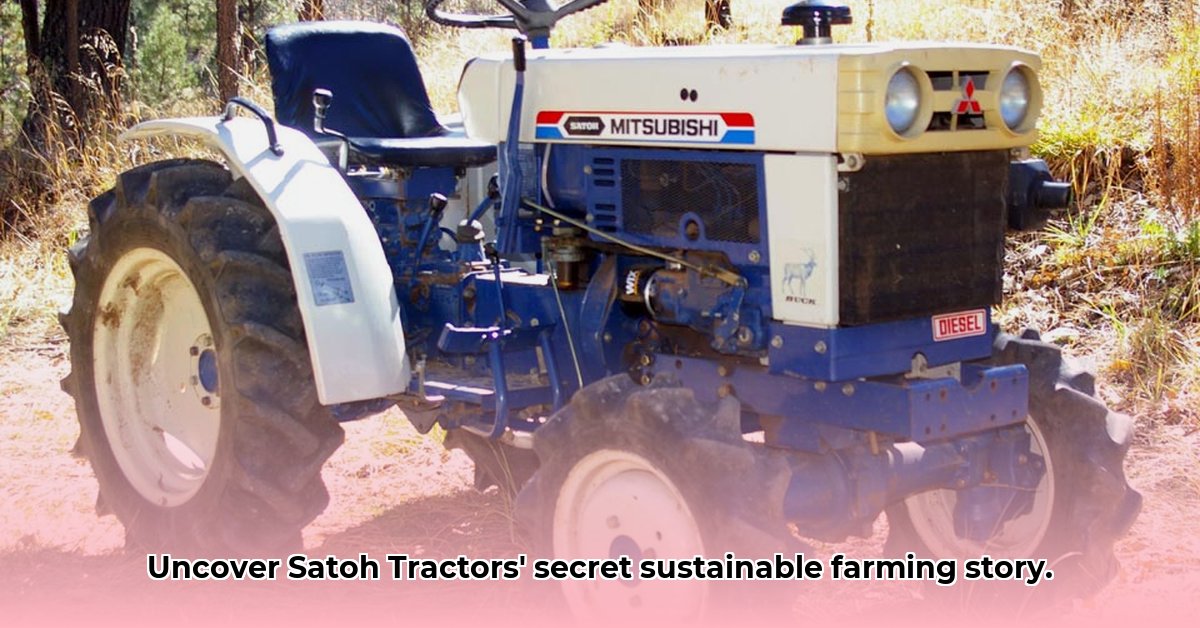
Satoh Tractors: A Legacy of Innovation in Sustainable Farming
The story of Satoh tractors offers a compelling narrative within the broader context of sustainable agriculture and technological advancements. While lacking comprehensive data, its history—particularly its merger with Mitsubishi—provides valuable insights into the evolution of farming practices and the often-unseen impacts of agricultural machinery on the environment. This article explores the limited available information, aiming to illuminate Satoh's contributions and highlight the need for greater transparency in the agricultural technology sector. For comparisons, see reviews on other tractor brands like Kioti here. Did you know that the seemingly obscure Satoh tractor played a significant role in shaping modern farming? Its influence extends beyond its powerful engine, revealing a fascinating interplay of technological innovation, corporate mergers, and the growing awareness of environmental sustainability.
A Partnership Forged: The Satoh-Mitsubishi Merger
The 1980 merger between Satoh and Mitsubishi marked a turning point. While precise details regarding the immediate environmental impact remain elusive, the merger likely resulted in increased efficiency in design and manufacturing. This could translate to thousands of tractors consuming slightly less fuel, cumulatively reducing the environmental footprint of agriculture. However, confirming this impact requires more thorough historical investigation—a challenge faced when considering the limited availability of readily accessible data on Satoh's specific environmental performance. This lack of data, however, also highlights a larger issue within the industry.
The Data Deficit: Unveiling the Hidden Story of Environmental Impact
The scarcity of detailed historical data on Satoh's environmental impact presents a significant hurdle in fully understanding its contribution to sustainable farming. This lack of readily available information is not unique to Satoh; it reflects a broader issue within the agricultural machinery industry's historical data collection practices. The absence of precise figures on fuel efficiency, emissions, and lifespan hinders efforts to accurately quantify Satoh's impact. A significant call to action here: future research must prioritize transparent, detailed data collection on agricultural machinery across the board.
A Broader Context: Technological Advancement and the Growing Environmental Consciousness
Understanding Satoh’s legacy necessitates examining its historical context. The merger coincided with growing global awareness of environmental issues. While direct causation is difficult to prove, it's plausible that the prevailing environmental concerns influenced the development and manufacturing of more efficient and sustainable agricultural technologies. This suggests a much larger and more complex story than the narrative of a single company. It highlights the broader movement toward environmentally responsible practices within the agricultural industry as a whole.
The Future of Farming: Transparency and Collaboration in Sustainable Agriculture
The Satoh story, despite its data limitations, underscores the vital need for improved transparency in data collection across the agricultural machinery industry. The creation of a comprehensive, publicly accessible database detailing the environmental impact of various farm equipment models would be an invaluable contribution to sustainable agriculture research. This collaborative effort would aid in future studies and enable more informed decision-making.
Furthermore, companies like Mitsubishi could contribute significantly by being more transparent about their past sustainability initiatives and actively collaborating with researchers to fill historical data gaps. Openness and collaboration are paramount to creating a more sustainable future for agricultural practices.
A Call to Action: Practical Steps Towards a Greener Future
The following steps can be implemented to address the data gap and promote sustainable agricultural practices:
- Agricultural Historians: Conduct detailed research of Satoh’s history, focusing on environmental impact. Partner with organizations to develop a publicly accessible database on agricultural machinery.
- Sustainable Ag Researchers: Conduct comparative analyses of fuel efficiency and emissions across different agricultural machinery, including modern and legacy models. Fund long-term studies assessing the long-term environmental effects of various farming technologies.
- Mitsubishi Agricultural Machinery: Increase transparency by publicly releasing data on past and present sustainability initiatives. Invest heavily in R&D for eco-friendly machinery advancements.
- Farmers and Consumers: Prioritize research into fuel-efficient and sustainably produced models when purchasing machinery. Advocate for stronger, more transparent sustainability standards within the industry.
The story of Satoh tractors shows the intricate relationship between technological development, sustainable practices, and responsible farming. While the complete picture requires further research, the available evidence emphasizes the urgency of collaborative research, data transparency, and proactive environmental stewardship within the agricultural technology sector. This collective effort is crucial for creating a more sustainable and responsible future for agricultural practices globally.